The Saturday evening event was Duval Uncorked. Duval Street is the main walking-shopping-gallery-club-restaurant street in Key West, and this event opened it all up. Dozens of restaurants, bars, clubs, and shops welcomed Festival participants with small plates and endless wine.
Don't be spooked; the gentleman above is a mannequin in the Banana Republic shop, not a decapitated local. There were three starting points along the Duval Street route, and you could be drunk before you get a fraction of the way through. We began after sunset at Mallory Square.
Restaurants gave out tastes from their own menus, maybe a little dish of ceviche or pasta, chicken salad with chutney, empanadas, bruschetta or nachos, and a shot-sized serving of wine, or microbrewery beer, or appletini. At first, it was a lot like attending a wedding that was moving along an escalator. Later, it felt like we were in an adult trick-or-treating universe. I'd go up to the door and say "uncorked". They'd send me to the back as though I'd uttered the password in a speakeasy. Then they'd be disappointed unless I ate and drank too much.
You'd go into a fussy gallery and look at the label of the wine they'd specially picked. Then you'd amble across the street to a club and have a blue jello shot with two transvestites who'd make Cher look plain. We went from tasting everything, to giving up on drinking (there were cross-streets and traffic involved), to eating only every other opportunity, to sneaking a peek instead of a taste and ducking in for ice cream and the end of eating. Even the ice cream shop was giving out shot-sized portions of wine-flavored sorbet.
By eight o'clock, the food orgy was over. But this is Key West. I suppose that this was the time for everyone to go out to eat and then get really drunk. Sunday morning will be quiet, I'm sure.










